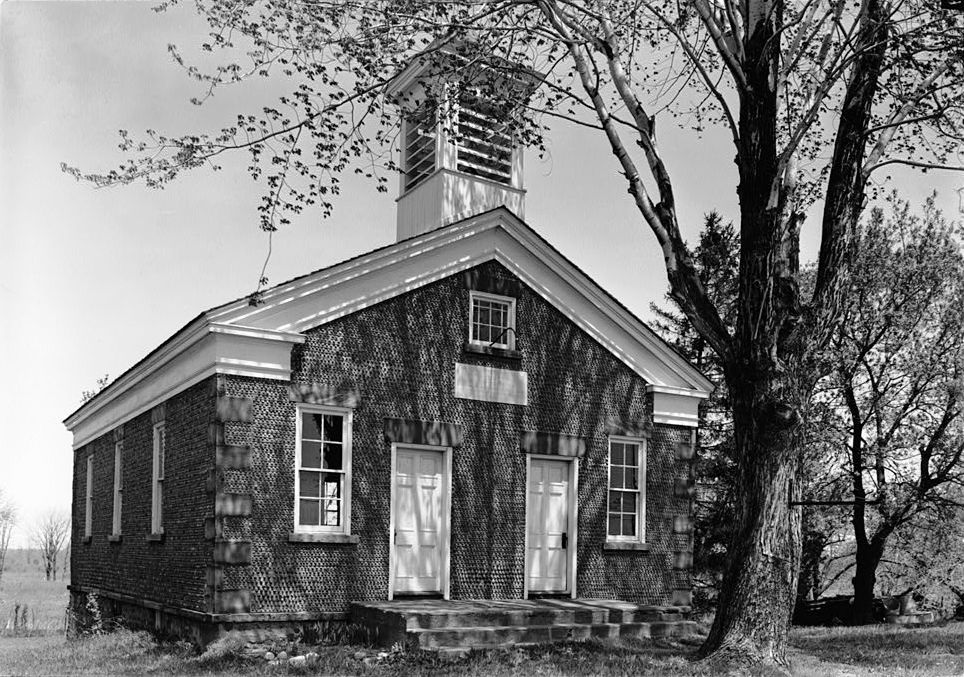|
Sliker Cobblestone House
Sliker Cobblestone House is a historic home located at Conesus in Livingston County, New York. It consists of a -story frame structure with a 2-story visually dominant cobblestone portion and 1-story rear shed addition. It features medium-sized field cobbles set in horizontal rows in its construction. The interior features Federal-style details. Also on the property are four contributing outbuildings: a shed, four privies, and a barn dating to about 1900. ''See also:'' It was listed on the National Register of Historic Places The National Register of Historic Places (NRHP) is the United States federal government's official list of districts, sites, buildings, structures and objects deemed worthy of preservation for their historical significance or "great artistic ... in 2007. References Houses on the National Register of Historic Places in New York (state) Cobblestone architecture Houses in Livingston County, New York National Register of Historic Places in ... [...More Info...] [...Related Items...] OR: [Wikipedia] [Google] [Baidu] |
Conesus, New York
Conesus is a Administrative divisions of New York#Town, town in Livingston County, New York, Livingston County, New York (state), New York, United States. The population was 2,473 at the 2010 census. The name is derived from a native word meaning "berry place". Conesus is on the county's east border, and is north of Dansville, Livingston County, New York, Dansville. History Settlement began ''circa'' 1795. In 1819, Conesus was formed from parts of the towns of Groveland, New York, Groveland and Livonia (town), New York, Livonia as the "Town of Freeport". The name was changed to "Browersville" in March 1825 and was changed to "Conesus" a month later. Conesus is home to the former St. Michael's Mission, a school for Catholic priests that operated from the 1930s until the 1970s. The sprawling complex on Mission Road is now owned by an evangelical Christian church from Colorado Springs. The Conesus Amusement Hall, Kellerman Log Cabin, Payne Cobblestone House, and Sliker Cobbleston ... [...More Info...] [...Related Items...] OR: [Wikipedia] [Google] [Baidu] |
Livingston County, New York
Livingston County is a county in the U.S. state of New York. As of the 2020 census, the population was 61,834. Its county seat is Geneseo. The county is named after Robert R. Livingston, who helped draft the Declaration of Independence and negotiated the Louisiana Purchase The Louisiana Purchase (french: Vente de la Louisiane, translation=Sale of Louisiana) was the acquisition of the territory of Louisiana by the United States from the French First Republic in 1803. In return for fifteen million dollars, or app .... Livingston County is part of the Rochester, New York, Rochester Rochester, New York metropolitan area, Metropolitan Statistical Area. History On February 23, 1821, Livingston County, New York was formed from Ontario County, New York, Ontario and Genesee County, New York, Genesee Counties. The twelve original towns were: Avon, New York, Avon, Caledonia, New York, Caledonia, Conesus, New York, Conesus, Geneseo, New York, Geneseo (county seat), Groveland, Ne ... [...More Info...] [...Related Items...] OR: [Wikipedia] [Google] [Baidu] |
Cobblestone Architecture
Cobblestone architecture refers to the use of cobblestones embedded in mortar as method for erecting walls on houses and commercial buildings. It was frequently used in the northeastern United States and upper Midwest in the early 19th century; the greatest concentration of surviving cobblestone buildings is in New York State, generally near the historic Erie Canal or connecting canals. History Evidence of the use of cobblestones in building has been found in the ruins of Hierakonpolis in Egypt. Houses were built of mud brick set on cobblestone foundations. Cobblestone architecture may have been used on a monumental scale to erect public administrative centers or palaces. Those structures have since collapsed into mounds of stone.Ring, Trudy et al. ''International Dictionary of Historic Places: Middle East and Africa'',Google Books, Taylor & Francis, 1996, pp. 345-46, (). Cobbles, mostly flint, became a common building material from the Middle Ages onwards in England and a few p ... [...More Info...] [...Related Items...] OR: [Wikipedia] [Google] [Baidu] |
Federal Architecture
Federal-style architecture is the name for the classicizing architecture built in the newly founded United States between 1780 and 1830, and particularly from 1785 to 1815, which was heavily based on the works of Andrea Palladio with several innovations on Palladian architecture by Thomas Jefferson and his contemporaries first for Jefferson's Monticello estate and followed by many examples in government building throughout the United States. An excellent example of this is the White House. This style shares its name with its era, the Federalist Era. The name Federal style is also used in association with Federal furniture, furniture design in the United States of the same time period. The style broadly corresponds to the classicism of Biedermeier style in the German-speaking lands, Regency architecture in Britain and to the French Empire style. It may also be termed Adamesque architecture. The White House and Monticello were setting stones for federal architecture. In the ... [...More Info...] [...Related Items...] OR: [Wikipedia] [Google] [Baidu] |
Outhouse
An outhouse is a small structure, separate from a main building, which covers a toilet. This is typically either a pit latrine or a bucket toilet, but other forms of dry toilet, dry (non-flushing) toilets may be encountered. The term may also be used to denote the toilet itself, not just the structure. Outhouses were in use in cities of Developed country, developed countries (e.g. Australia) well into the second half of the twentieth century. They are still common in rural areas and also in cities of developing countries. Outhouses that are covering pit latrines in densely populated areas can cause groundwater pollution. Increasingly, "outhouse" is used for a structure outside the main living property that is more permanent in build quality than a shed. In some localities and varieties of English, particularly outside North America, the term "outhouse" refers ''not'' to a toilet, but to outbuildings in a general sense: sheds, barns, workshops, etc. Design aspects Common ... [...More Info...] [...Related Items...] OR: [Wikipedia] [Google] [Baidu] |
New York State Office Of Parks, Recreation And Historic Preservation
The New York State Office of Parks, Recreation and Historic Preservation (NYS OPRHP) is a state agency within the New York State Executive Department Parks, Recreation and Historic Preservation Law § 3.03. "The office of parks, recreation and historic preservation is hereby continued in the executive department. .. charged with the operation of state parks and historic sites within the U.S. state of New York. As of 2014, the NYS OPRHP manages nearly of public lands and facilities, including 180 state parks and 35 historic sites, that are visited by over 78 million visitors each year. History The agency that would become the New York State Office of Parks, Recreation and Historic Preservation (NYS OPRHP) was created in 1970; however, the history of state parks and historic sites in New York stretches back to the latter part of the 19th century. Management of state-owned parks, and guidance for the entire state park system, was accomplished by various regional co ... [...More Info...] [...Related Items...] OR: [Wikipedia] [Google] [Baidu] |
National Register Of Historic Places
The National Register of Historic Places (NRHP) is the United States federal government's official list of districts, sites, buildings, structures and objects deemed worthy of preservation for their historical significance or "great artistic value". A property listed in the National Register, or located within a National Register Historic District, may qualify for tax incentives derived from the total value of expenses incurred in preserving the property. The passage of the National Historic Preservation Act (NHPA) in 1966 established the National Register and the process for adding properties to it. Of the more than one and a half million properties on the National Register, 95,000 are listed individually. The remainder are contributing resources within historic districts. For most of its history, the National Register has been administered by the National Park Service (NPS), an agency within the U.S. Department of the Interior. Its goals are to help property owners and inte ... [...More Info...] [...Related Items...] OR: [Wikipedia] [Google] [Baidu] |
Houses On The National Register Of Historic Places In New York (state)
A house is a single-unit residential building. It may range in complexity from a rudimentary hut to a complex structure of wood, masonry, concrete or other material, outfitted with plumbing, electrical, and heating, ventilation, and air conditioning systems.Schoenauer, Norbert (2000). ''6,000 Years of Housing'' (rev. ed.) (New York: W.W. Norton & Company). Houses use a range of different roofing systems to keep precipitation such as rain from getting into the dwelling space. Houses may have doors or locks to secure the dwelling space and protect its inhabitants and contents from burglars or other trespassers. Most conventional modern houses in Western cultures will contain one or more bedrooms and bathrooms, a kitchen or cooking area, and a living room. A house may have a separate dining room, or the eating area may be integrated into another room. Some large houses in North America have a recreation room. In traditional agriculture-oriented societies, domestic animals such as ... [...More Info...] [...Related Items...] OR: [Wikipedia] [Google] [Baidu] |
Houses In Livingston County, New York
A house is a single-unit residential building. It may range in complexity from a rudimentary hut to a complex structure of wood, masonry, concrete or other material, outfitted with plumbing, electrical, and heating, ventilation, and air conditioning systems.Schoenauer, Norbert (2000). ''6,000 Years of Housing'' (rev. ed.) (New York: W.W. Norton & Company). Houses use a range of different roofing systems to keep precipitation such as rain from getting into the dwelling space. Houses may have doors or locks to secure the dwelling space and protect its inhabitants and contents from burglars or other trespassers. Most conventional modern houses in Western cultures will contain one or more bedrooms and bathrooms, a kitchen or cooking area, and a living room. A house may have a separate dining room, or the eating area may be integrated into another room. Some large houses in North America have a recreation room. In traditional agriculture-oriented societies, domestic animals such ... [...More Info...] [...Related Items...] OR: [Wikipedia] [Google] [Baidu] |







